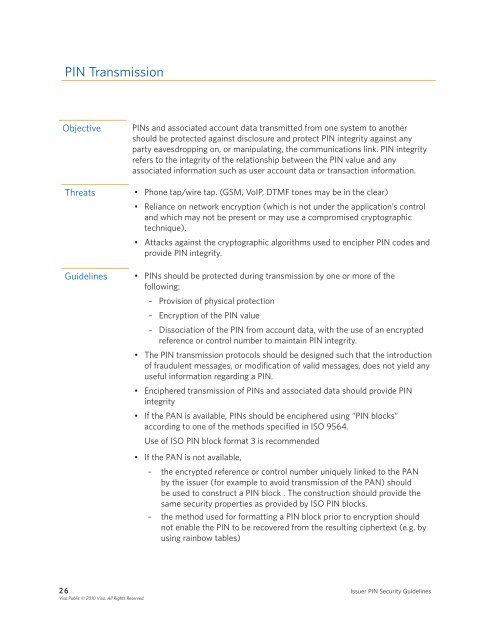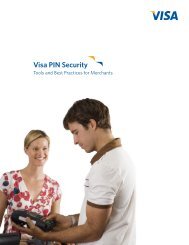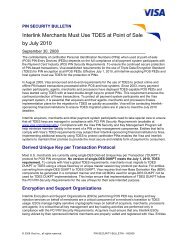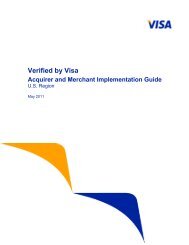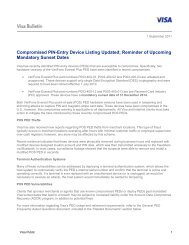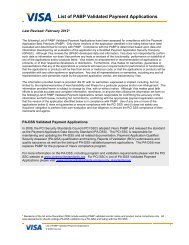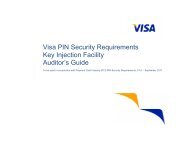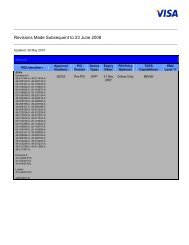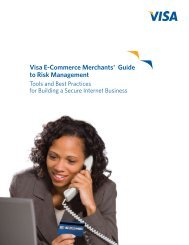Issuer PIN Security Guidelines - Visa
Issuer PIN Security Guidelines - Visa
Issuer PIN Security Guidelines - Visa
You also want an ePaper? Increase the reach of your titles
YUMPU automatically turns print PDFs into web optimized ePapers that Google loves.
<strong>PIN</strong> Transmission<br />
Objective <strong>PIN</strong>s and associated account data transmitted from one system to another<br />
should be protected against disclosure and protect <strong>PIN</strong> integrity against any<br />
party eavesdropping on, or manipulating, the communications link . <strong>PIN</strong> integrity<br />
refers to the integrity of the relationship between the <strong>PIN</strong> value and any<br />
associated information such as user account data or transaction information .<br />
Threats • Phone tap/wire tap . (GSM, VoIP, DTMF tones may be in the clear)<br />
• Reliance on network encryption (which is not under the application’s control<br />
and which may not be present or may use a compromised cryptographic<br />
technique) .<br />
• Attacks against the cryptographic algorithms used to encipher <strong>PIN</strong> codes and<br />
provide <strong>PIN</strong> integrity .<br />
<strong>Guidelines</strong> • <strong>PIN</strong>s should be protected during transmission by one or more of the<br />
following:<br />
– Provision of physical protection<br />
– Encryption of the <strong>PIN</strong> value<br />
– Dissociation of the <strong>PIN</strong> from account data, with the use of an encrypted<br />
reference or control number to maintain <strong>PIN</strong> integrity .<br />
• The <strong>PIN</strong> transmission protocols should be designed such that the introduction<br />
of fraudulent messages, or modification of valid messages, does not yield any<br />
useful information regarding a <strong>PIN</strong> .<br />
• Enciphered transmission of <strong>PIN</strong>s and associated data should provide <strong>PIN</strong><br />
integrity<br />
• If the PAN is available, <strong>PIN</strong>s should be enciphered using “<strong>PIN</strong> blocks”<br />
according to one of the methods specified in ISO 9564 .<br />
Use of ISO <strong>PIN</strong> block format 3 is recommended<br />
• If the PAN is not available,<br />
– the encrypted reference or control number uniquely linked to the PAN<br />
by the issuer (for example to avoid transmission of the PAN) should<br />
be used to construct a <strong>PIN</strong> block . The construction should provide the<br />
same security properties as provided by ISO <strong>PIN</strong> blocks .<br />
– the method used for formatting a <strong>PIN</strong> block prior to encryption should<br />
not enable the <strong>PIN</strong> to be recovered from the resulting ciphertext (e .g . by<br />
using rainbow tables)<br />
2 6 <strong>Issuer</strong> <strong>PIN</strong> <strong>Security</strong> <strong>Guidelines</strong><br />
<strong>Visa</strong> Public © 2010 <strong>Visa</strong>. All Rights Reserved.


